Table of Contents
Are you struggling to make SEO gains while your competitors dominate the search results? SEO is an essential channel for building the product-led growth flywheel that all SaaS companies hope to achieve. And, it can be frustrating to see competitors seemingly get there with ease.
Fortunately, you can kiss your SEO struggles goodbye. We'll provide you with a playbook detailing effective tactics for developing a high-growth SaaS SEO strategy and unlocking greater visibility in search engine results pages (SERPs). Read on to learn how to develop a high-growth SaaS SEO strategy.
Why Do So Many SaaS Companies Fail at SEO?
SEO is a critical growth channel for many SaaS companies, but so many get it wrong. Several issues can be pinpointed when looking at why this is the case.
First, there may not be any kind of strategy in place - SEO isn't something you just pursue aimlessly and expect results. Without an effective plan in place, it’s impossible to achieve results.
Additionally, SaaS companies may not have the right experts on hand who understand how best to use SEO to their advantage.
Content is also key - if it's low quality or outdated then search engines won't rank that content highly either.
Lastly, outdated tactics could have a negative effect on SEO efforts too; with algorithms consistently evolving, staying up to date with those changes is essential for success.
It's clear then that investing in SEO and understanding its complexities is crucial for SaaS companies who want to see success online - failure to do so comes at their own risk!
What do you need to do to guarantee a successful SaaS SEO strategy?
If done right, SEO can help you win new customers, increase brand recognition, and raise your bottom line. Here are the basics of SEO every B2B SaaS company should know:
- Understand your target audience and the keywords and phrases they use to search for solutions like yours
- Optimize website content and meta tags to include relevant keywords
- Use analytics to track website performance and identify areas for improvement
- Implement a content marketing strategy that attracts and engages your target audience
- Ensure your website is mobile-friendly, loads quickly, and is accessible to search engines
- Continuously monitor, measure and adjust your SEO strategy to adapt to search engine algorithm changes and to ensure you're staying ahead of your competitors.
5 Essential Ingredients for Your SaaS SEO Strategy
Before you start executing any SEO tactics, you need to get the foundation of your strategy in place. Otherwise, you’ll find yourself doing random acts of SEO that get you absolutely nowhere. Address these prerequisites before you kickstart your SEO program:
1. Define how SEO should support your desired business outcomes
Having your SEO strategy tied to your company's business goals is crucial for a number of reasons. First, it ensures that your SEO efforts are aligned with the overall direction and objectives of the company, which can help to maximize the impact of your efforts.
By understanding the specific goals and targets of the business, you can tailor your SEO strategy to best support them, whether that be increasing brand awareness, driving more sales, or something else entirely.
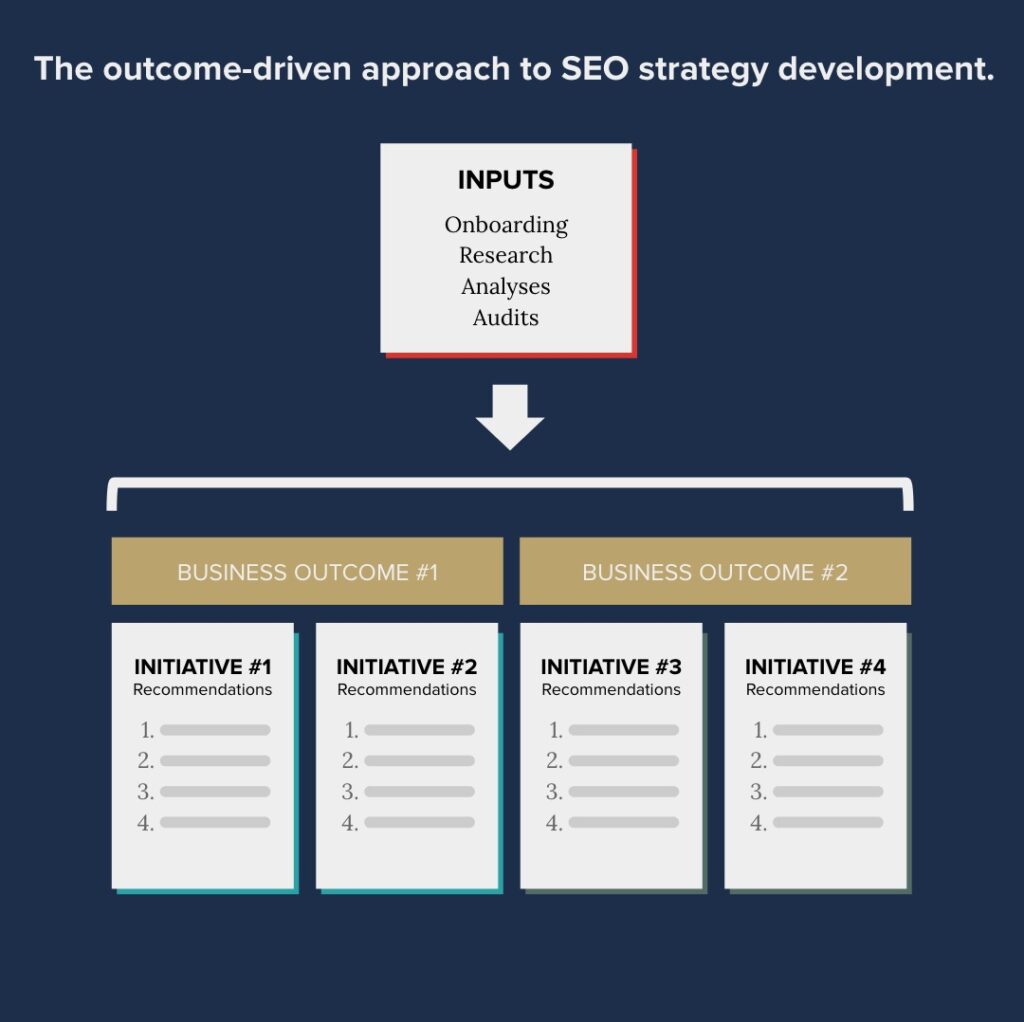
Additionally, tying your SEO strategy to your company's business goals can also help to prioritize your efforts and focus on the areas that will have the most impact. For example, if your business goal is to increase sales, then you may want to focus on optimizing your solutions pages and ensuring that they are highly visible in search results for relevant keywords.
On the other hand, if your goal is to increase brand awareness, then you may want to focus on creating high-quality, top-funnel content. By having a clear understanding of your company's business goals, you can ensure that your SEO efforts are focused on the areas that will have the most impact on the business.
2. Evaluate your current SEO strategy to understand what’s working and what’s not
Evaluating your current SEO strategy is an important step in understanding what is working and what is not, and making data-driven decisions about your efforts. Here are a few key steps that professional marketers at a SaaS company can take to evaluate their current SEO strategy:
- Set clear goals and objectives (See Tip #1): Before you can evaluate your SEO strategy, it's important to have a clear understanding of what you want to achieve. This should include specific, measurable, and time-bound goals, such as increasing website traffic, improving search engine rankings, or driving more sales.
- Analyze your performance: Once you have established your goals, it's important to analyze your SEO performance against them. Which tactics appear to be supporting your goals? Which ones seem to have little to no impact?
- Compare your performance against competitors: Compare your performance with industry benchmarks and your competitors. This will give you a better understanding of how your SEO strategy is performing in relation to the rest of the industry, which can help you identify areas where you need to improve.
3. Shore up your foundational SEO
Having a website with strong foundational SEO best practices is critical to success for a number of reasons. It ensures that your website is easily discoverable by search engines, which can help to drive more traffic to your site. This can be particularly important for SaaS companies, as a strong online presence can be crucial for acquiring new customers and driving sales.
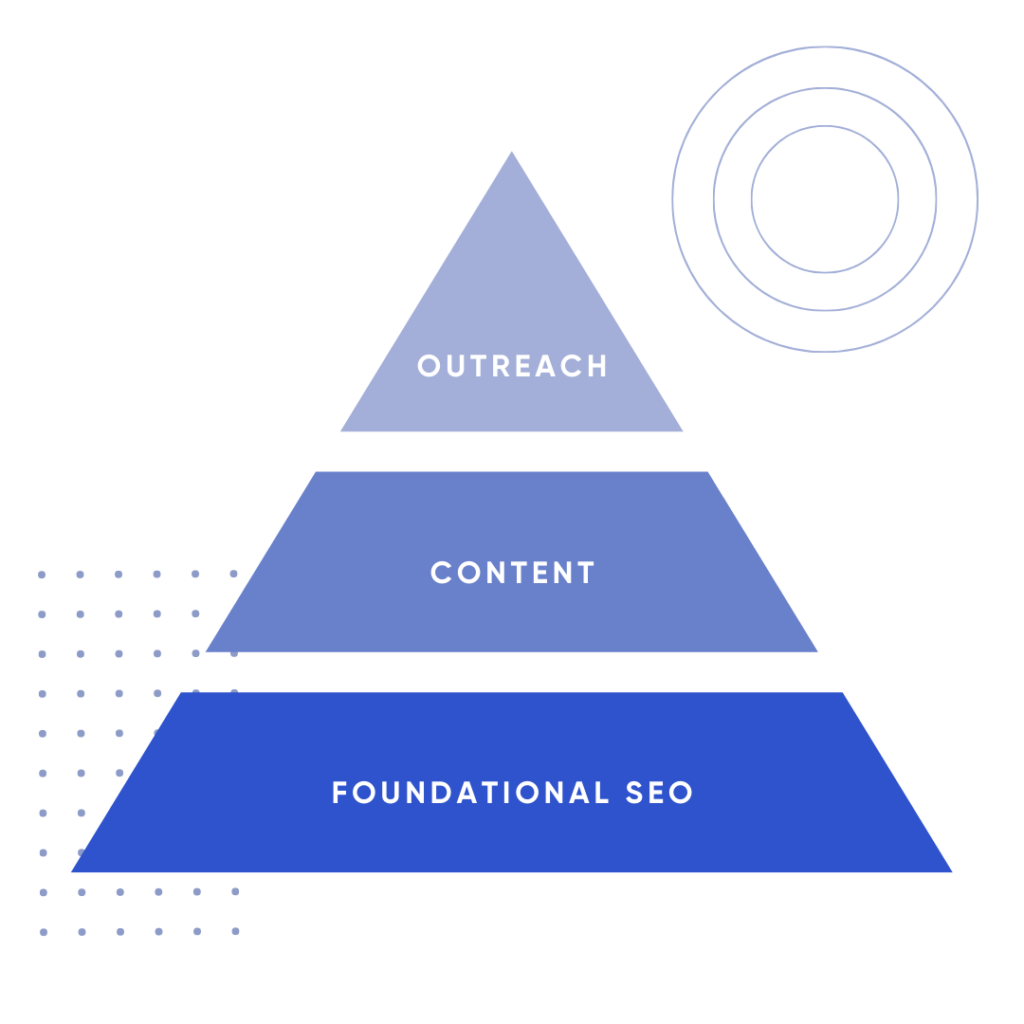
In addition, having a website with strong foundational SEO best practices can also help to improve the user experience for your visitors. For example, by ensuring that your website is fast-loading and easy to navigate, you can improve the overall experience for your visitors and increase the likelihood of them converting into customers.
4. Focus on creating great content and forget proactive, SEO-only link building
When your content is high-quality, informative, and relevant to your target audience, it will earn top keyword rankings. Those rankings will allow you to earn backlinks naturally. As an added benefit, content you create for SEO purposes can be repurposed for your other marketing channels.
On the other hand, black-hat link-building tactics can harm your website's search engine ranking and reputation. These tactics, such as buying backlinks or participating in link farms, violate search engine guidelines and can result in penalties that can damage your website's visibility in search engine results. Investing time and money into creating valuable content that resonates with your audience is a more sustainable and effective approach to improving your website's SEO performance.
5. Integrate SaaS SEO with your broader digital marketing strategy
Integrating your SEO strategy with your broader digital marketing strategy is important because it allows you to leverage the strengths of multiple channels to achieve your business goals. When all of your marketing efforts are aligned and working together, you can more efficiently reach and convert your target audience.
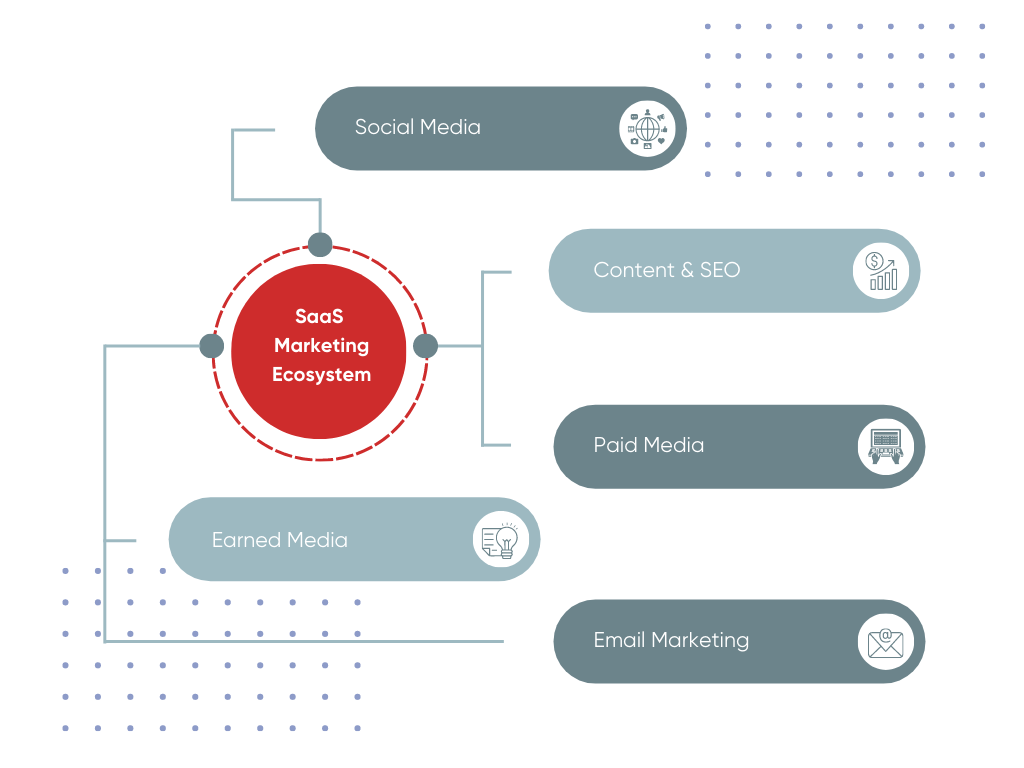
Siloing your SEO strategy from your other marketing channels can lead to several pitfalls, such as:
- Inefficient use of resources: When your SEO strategy is siloed, you may be duplicating efforts or missing opportunities to optimize your content for other channels.
- Inconsistent messaging: When your SEO strategy is disconnected from your other marketing channels, it can lead to inconsistent messaging across different platforms, which can confuse and disengage your audience.
- Limited reach: When your SEO strategy is not integrated with your other marketing channels, you may be missing out on opportunities to reach your target audience through multiple touchpoints, which can limit the effectiveness of your efforts.
The SaaS SEO Playbook: Strategic Pillars to Build Upon
Build an Efficient Content Production Workflow
Your SEO strategy will only take you as far as your content capabilities allow. A well-oiled content production workflow will allow you to earn organic keyword rankings, engage your target audience, and ultimately lead to more conversions and recurring revenue.
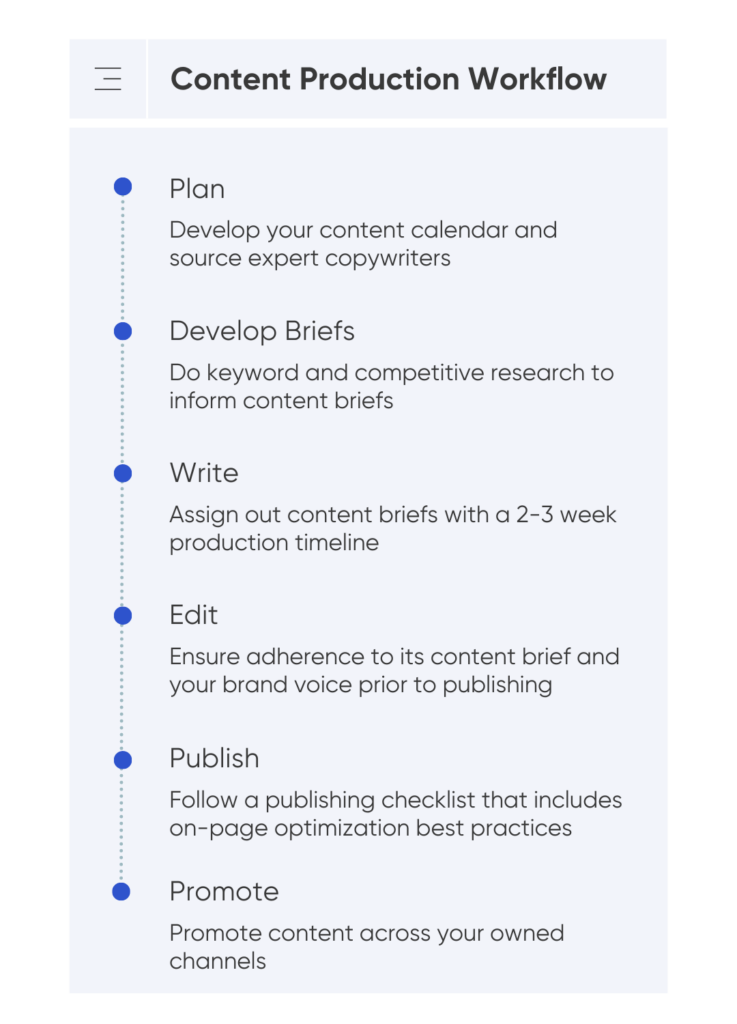
Here are the building blocks of a strong content production workflow for SaaS companies:
- Start slow to work out the kinks, but eventually build to an aggressive content publishing cadence with a crack team of content specialists and copywriters
- Have your content/SEO specialists create detailed content briefs, informed by keyword and competitive research, for each article
- Pass the content briefs onto your copywriters and set a 2- to 3-week timeframe for production
- Edit each article to ensure adherence to its content brief and your brand voice prior to publishing
- Publish each article according to an agreed-upon checklist that includes on-page optimization, internal linking, and injecting CTAs.
- Promote content across your owned channels and submit each new article to Google Search Console to ensure speedy indexing
In addition to helping you rank higher in search engines, this content production workflow also helps you attract and engage your target audience. By creating valuable and informative content, you are providing your target audience with the information they need to make informed decisions.
Finally, know that not all content works for SEO, but all SEO content works cross-channel. By producing high-quality content that is shareable and engaging, you increase the chances of your content being shared on social media platforms and clicked on in your email newsletter. This not only helps you increase your reach and visibility but also helps you get more mileage out of your content efforts.
Focus on Valuable “Keyword Templates”
The biggest mistake SaaS companies make when it comes to SEO-focused content production is a lack of strategy in their keyword selection & topic identification. A common, and ineffective, approach is to have a running list of assorted keywords that is occasionally refreshed by keyword research projects and stakeholders’ opinions.
Instead of first looking for individual keywords, look for common “keyword templates.” These are opportunities whereby a word or phrase within a keyword can represent a wildcard. You can substitute that wildcard for potentially dozens or more subtopics.
Now, that single content idea has become a scalable keyword template. Scalable keyword templates are easy to overlook. Here’s a handful that we know to look for when it comes to SaaS companies:
- Top-funnel keyword templates:
- “[concept a] vs [concept b]”
- “what is [concept]”
- Mid-funnel keyword templates:
- “how to [accomplish task or alleviate pain point]”
- “[key function] template”
- “[key function] examples”
- Bottom-funnel keyword templates:
- “[competitor] alternatives”
- “[competitor a] vs [competitor b]” (vs [your SaaS company])
- “best [function] tools/software”
- “best [software] with [feature or integration]”
- “best [software] for [audience type]”
With these templates, you can spend less time on content planning and more time on strategic content execution.
Optimize Your Existing Content at Least Once Per Year
If lack of keyword strategy is the biggest SEO mistake that SaaS companies make, then failing to optimize existing content is the second. Don’t think of your SEO-focused content as one-offs. Instead, view them as evergreen assets that need to be regularly tended to.
What’s the cost of not optimizing existing content? Invariably, what will happen is that the performance of aging content will begin to decay. Google rewards freshness. So, as your competitors publish new content and refresh their existing content, you’ll find that your rankings slip down the page with time.
You can ascend to the top and stay there with a disciplined approach to existing content optimization. At minimum, we recommend that you revisit each asset in your content library at least once per year. Here’s what should you do to optimize existing content:
- Review the top-ranking competitors for the target keyword to determine what your content is lacking
- Inject new information into the article and remove anything outdated
- Build internal links to more recently-published content
- Updated article headlines that contain the year
- Update the article’s publish date
Pursue Targeted Backlink Opportunities that Drive Referral Traffic
Building backlinks for the sake of building backlinks is the biggest SEO money pit. Stay far away from it! However, that’s not to say you should avoid backlink building altogether. You should look to build backlinks that have the potential to send referral traffic your way. And, not just any referral traffic but actual potential customers.
Where do you find these types of backlink opportunities? In the search results, of course. Aim to build backlinks in content that is ranking well for target keywords that matter to your SaaS business.
Here’s an example of our client Integrate.io. They are an ETL software, so the keyword “etl tools” is one that matters a ton to their business. They have a high-ranking article on that topic, but what they’ve done that’s genius is earned backlinks from many of the other top-ranking articles in the SERP.
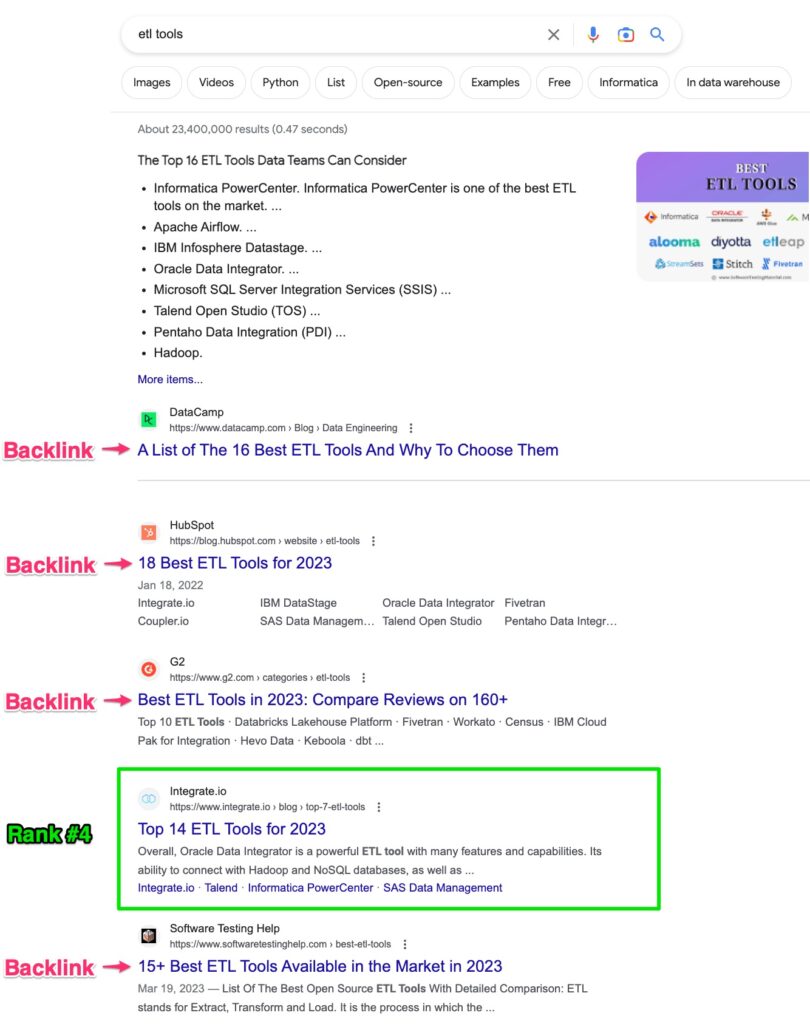
That way, if a potential customer clicks on any of the top-5 results for “etl tools”, they’re going to see Integrate.io and a handy backlink they can use to navigate to their domain.
The Top SaaS SEO Resources for 2023
1. Uproer’s Searchlite Newsletter
Our very own newsletter is a fantastic resource for informative SaaS SEO content. Subscribe to get a monthly email full of SaaS SEO tips, case studies and insights.
2. Search Engine Journal
Search Engine Journal is another great resource for those looking to learn about SaaS SEO. The website features a variety of articles and tutorials on topics such as link building, local SEO, and mobile SEO. Additionally, the website has a search engine optimization forum where users can ask questions and get advice from other SEO experts.
3. HubSpot
HubSpot is a marketing software company that offers a number of resources for learning about SaaS SEO. The company’s blog features articles on topics such as content marketing, inbound marketing, and social media marketing. Additionally, HubSpot offers a number of free eBooks and guides on SEO, which can be downloaded from the company’s website.
4. The Moz Blog
The Moz Blog is one of the best resources for learning about SaaS SEO. The blog covers a wide range of topics related to SEO, including link building, keyword research, and on-page optimization. Additionally, the blog features guest posts from some of the top SEO experts in the industry.
SaaS SEO Strategy FAQs
What are the best tools for tracking and analyzing SaaS SEO performance?
Check out our full article on the best SEO tools for SaaS companies. For a snapshot, read on below:
1. Google Analytics
Google Analytics is a free tool that can be used to track and analyze SEO performance. The tool can be used to track website traffic, keyword rankings, and conversion rates. Additionally, Google Analytics can be used to create custom reports that can help to identify areas of improvement.
2. SEMrush
SEMrush is a paid tool that offers a variety of features for tracking and analyzing SEO performance. The tool can be used to track keyword rankings, backlink profiles, and website traffic. Additionally, SEMrush provides a competitive analysis feature that can be used to compare your website’s SEO performance to that of your competitors.
3. Moz
Moz is another paid tool that offers a variety of features for tracking and analyzing SEO performance. Similar to SEMrush, Moz can be used to track keyword rankings, backlink profiles, and website traffic. Additionally, Moz provides a “Site Crawl” feature that can be used to identify technical issues with your website that may be impacting your SEO performance.
4. Ahrefs
Ahrefs is yet another paid tool that offers a variety of features for tracking and analyzing SEO performance. Like the other tools on this list, Ahrefs can be used to track keyword rankings, backlink profiles, and website traffic. Additionally, Ahrefs provides a “Content Explorer” feature that can be used to find popular content in your industry that is performing well in search engines.
5. Google Search Console
Search Console is a free tool offered by Google that can be used to track and analyze your website’s SEO performance. The tool provides data on your website’s search traffic, keywords, and any manual actions taken by Google against your site. Additionally, Search Console can be used to submit your website’s sitemap to Google and request indexing of new or updated content
How can I use link building to improve my SaaS SEO strategy?
When considering how to approach link building, it’s important to consider your investment of time and money against other SEO tactics. Building high-quality, relevant links is far more worthwhile than trying to acquire a large volume of links through time-consuming or inauthentic tactics. Here are a few ways you can use link building to improve your SaaS SEO strategy:
- Create valuable content: Developing high-quality, informative content that addresses the needs and interests of your target audience is a great way to attract natural links. This can include blog posts, infographics, videos, and other types of content that people will want to share and link to.
- Reach out to influencers and thought leaders: Identify industry influencers and thought leaders in your niche, and reach out to them to let them know about your content. This can help to get your content in front of a new audience and attract natural links.
- Build relationships with other websites: Building relationships with other websites in your niche can help to establish your brand as a respected authority in your industry. This can also lead to natural link opportunities as other websites may want to link to your content to provide value to their own audience.
- Leverage social media: Share your content on social media platforms and engage with your followers. This can help to attract natural links from people who see your content on social media and want to share it on their own website.
- Avoid black hat tactics: Never engage in black-hat link-building tactics, such as buying links or participating in link farms, as these can lead to penalties from search engines and harm your SEO.
What are the most important SEO metrics to track for a SaaS website?
There are many different SEO metrics that a SaaS company can track to measure the performance of its website and identify areas for improvement. However, you should focus on metrics that ladder up to your business goals as these are the most important in evaluating your success.
Final Tip: Don’t Underestimate the Power of a Great SaaS SEO Agency
If you’re looking to take your SaaS company’s SEO game up a notch, consider enlisting the help of an experienced SaaS search marketing agency like Uproer. We have a team of passionate experts who live and breathe all things SaaS SEO—and we’d be more than happy to put our skills to work for you. Contact us today to learn more about what we can do for you.

